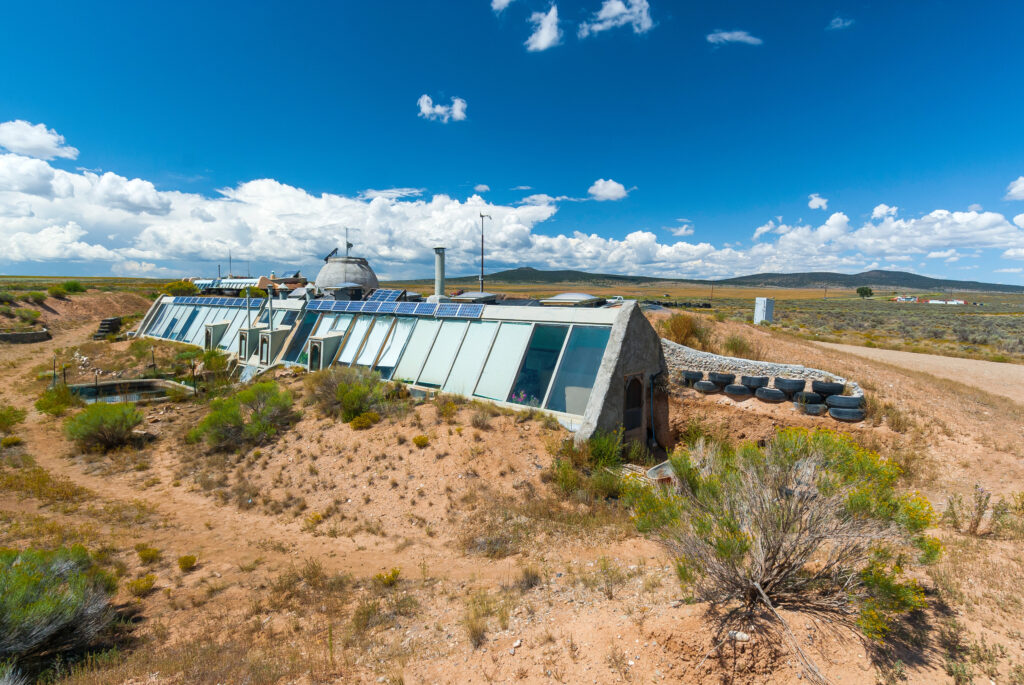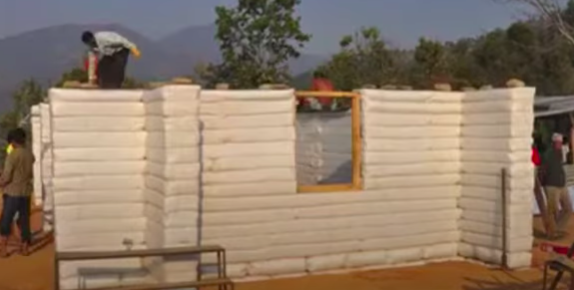Let’s talk about building a house with the resources around you, the earth, recycled and purchased materials, and see which is better. Now, better when it comes to housing is relative. It’s all about the lifestyle and your choices to get the lifestyle you want. A better house for you might not be ideal for your neighbor, friends, or family. That’s why in our which is better article, we are going to tackle understanding what our three alternative housing options of an Earthship, Earth Berm and EarthBag house are, the materials used the build them, an average of what those materials cost, the time it typically takes to build and some pros and cons of each. Hang on; it’s about to get messy.
An Earthship, Earth Berm, and EarthBag houses have one significant component that is the same: using the resources around you to create the foundation, structure, walls, and roof so you can determine which type of home is better for you. We will show you which uses mostly recycled materials – all three, which cost the most – Earthships, which you can DIY the easiest – EarthBag and which will involve a lot of digging – Earth berm and how you can live comfortably in all three alternative housing options.
| EarthShip | Earth Berm | Earth Bag | |
| What | Off-grid home, self-sustaining home. Build with recycled materials, concrete, or adobe. | Earth-sheltered homes are built underground with a courtyard or accessway. Earth berm home built partially underground. | Home constructed from earthbags filled with locally sourced materials, barbed wire, and plaster. |
| Materials | Recycled Materials + Water + Solar or Wind Turbine System. | Earth–flat or hilly, concrete, lumber, regular electrical, conduit, ductwork, flooring, lighting, and windows as traditional construction. | Polypropolene or mesh fabric bags, soil, sand, clay, insulative material if necessary, Shovel, bucket, garden hose, tamper, slider, wire cutters, level. |
| Cost | $100,000–$1,500,000 for a 1 to 3 bedroom home. | $33 for a 24 foot modular shell. All other building costs are added on top. As a DIY others have built earth berm homes for $62,000. | $6000–$10,000 for a 30-foot roundhome. |
| Time | Up to 2 years. | Shell complete in 15-20 days. If DIY, It could take up to 2 years. | 6 months to a year. |
| Pros | Self-sustaining, no utility bills, and can grow food. | Protection from tornadoes and other extreme weather, a lot of natural light, no noise from the neighbors or street, close to nature, saves 80% on energy costs and is long-lasting. | Earthquake, tornado, hurricane, flood, bullet, termite, varmint resistant, inexpensive, easy to learn and build, non-toxic, ecological-using mostly earth, versatile in building styles, use a simple foundation. |
| Cons | The upfront cost is high, may not be able to produce all utilities or food. | With poor construction, they can leak, flood, have limited landscaping, crack during an earthquake, be expensive to repair, mold, depreciate value, pests. | local building approval may be difficult; you have to plan properly with an engineer and the building inspectors and finish the bags with an appropriate plaster. |
| DIY | It is possible, but you do need to take a permitting course for $2,500. | Can be dug and built in 3 months. | Yes, this is a great DIY build. |
| Hire a contractor | Not many know how to build an Earthship. You would be best hiring the originating company Earthship Global. | Some companies build for under $100,000. | Yes, you can hire a contractor to do the work. This will increase the costs. Overall, you’ll be hiring an architect and/or structural engineer to approve the design and plans. |
Earthships

What makes a house an Earthship?
An Earthship is a house made out of recycled materials such as tires, bottles, and cans, the earth, and non-polluting renewable energy to meet most if not all cooling, heating, water, and power needs.
What do Earthships do?
Earthships are designed to be off-grid and self-sufficient. They are built with a water collection system that uses water from condensation, rain, and snow. This is channeled through silt-catching devices into a cistern.
The collected water is used four times in an Earthship, and then you could argue indefinitely.
- The water is used first for drinking after it passes through a filtering system called a water organization module. According to earthshipbiotecture.com, the “Water Organizing Module Distributes the fresh drinking water through the building at code required pressure. Water from the city, your cistern, or well, etc., can all be hooked up to the WOM. You can add automated systems to manage the connection to multiple water sources to keep the cistern supplied with water.”
- The water then passes to your home’s plumbing for the faucets, showers, or tubs.
- The wastewater from your sinks, showers, and tubs is “grey” water used in the toilets. Water from your kitchen sinks moves directly to “black” water, and it is not recommended to use blackwater from laundry that washed soiled diapers.
- The greywater used in the toilets is then considered “black” water and used in exterior watering for plants. It is not recommended to use blackwater on edible plants.
You can get an additional rain collection system for your home as well.
The rest of the home’s systems run off solar panels, air purification with a sunroom with large windows for light, heat, and to help plants grow. Solar panels or wind turbines ideally provide all of the electricity you need for appliances and your lifestyle. The windows provide the primary source of light and heat, while you might need an axillary unit for heating and cooling, depending on the climate.
How much does an Earthship home cost to build?
Homes built by Earthship Biotecture range from $100,000 for smaller models to $1.5 million for the Phoenix Earthship, the company’s most luxurious Earthship rental. This is not a “cheap” way to build a house, but ideally, if the systems run correctly, the plan is not to pay a utility bill again.
How many hours does it take to build an Earthship?
Depending on the size and style, a typical Earthship requires 700 to 1,500 tires to build the foundation. It takes around 15 to 20 minutes to pack a tire full of earth, which means around 400 hours of work for 1,000 tires. After the tires are full, you have the remainder of the house to build out of concrete, or adobe, and recycled materials. As a labor of love, it could take up to two years to build.
Are Earthships worth it?
The upfront cost of an Earthship can be higher than building a traditional home. There are no realized cost savings in designing and building an Earthship over a conventional home. The value comes in living in an off-grid home that is 90% self-sufficient with a minuscule carbon footprint. Earthships are more about environmental consciousnesses, not cost-effectiveness.
Where are Earthships in the US?
There are Earthships communities in New Mexico and Colorado. If you want to experience staying in an Earthship, you can visit the Earthship Biotecture headquarters in Taos, NM, and rent one.
Where can Earthships be built?
Earthship Global has built in Germany, Mexico, France, Canada, and the United States. They have construction drawings available for purchase that range from studio to three bedrooms.
Building with recycled materials is a great way to reuse items that would otherwise end up in a landfill. Another eco-friendly way to build is by using as minimal materials as possible to build an earthbag house.
Earthbag homes

What is an Earthbag house?
An Earthbag is a house built out of lightweight polypropylene material or fabric and filled with soil, gravel, clay, and, if necessary, a mix of insulative material like scoria, pumice, perlite, vermiculite, or rice hulls. Most earthbag homes are built in warmer climates; however, extra insulation or adding insulative materials to your bags can allow you to build in colder climates where it does reach 32°F. Adding plaster stucco to the outside of the home in colder climates will also help with weatherproofing. In warmer climates, you can use a coating of cob or adobe to do the same things.
How long do earthbag homes last?
An earthbag home can last a very long time. The natural materials used to fill the bags will not deteriorate. They could last for centuries if properly maintained.
Are earthbag homes well insulated?
You can insulate an earthbag building with the thermal mass of the filled bags (specific material’s ability to absorb but also store and radiate heat), or you can add insulation to the bag during the building process. In this way, earthbag homes can be adapted for cold climates with an insulating fill material. Pumice, perlite, scoria, vermiculite, or rice hulls are suitable insulating materials.
How long does it take to build an earthbag house?
One couple built their lofted earthbag house of 113 square feet and attached kitchen and bathroom in 1,333 man-hours. Their process took 50 tons of fill which they sourced locally. Their total cost with recycled, gifted, reclaimed, and reused materials was $6,164. You can see their inspiring story on insteading.com.
Are earthbag homes cheaper?
Earthbags homes are cheaper than building with conventional materials. The bags can be purchased recycled at a fraction of the cost of new bags. The fill can be locally sourced either at your build site or from the local landscaping company. The layers of earthbags are kept together with twine or barbed wire to add tensile strength. These materials are cheaper than conventional lumber, cement, steel, equipment costs, fuel, and transportation expenses.
How much do earthbag homes costs?
According to the experts at earthbagbuilding.com, earthbag homes can cost around $16 per square foot. If you purchase new materials and hire contractors for a DIY house, those costs could jump. An example they had was a 30 foot round home that could cost between $6,000 – $10,000, using local and recycled materials.
How tall can you build an earthbag home?
The rule of thumb for an earthbag home is that you can build up to ten times the width of the wall, so with a 15-inch wall, you could theoretically go up about 12-feet.
How do you seal an earthbag?
You can cover earthbag walls with lime and sand mixture, tapioca and soil plaster, concrete, and stucco. Once mixed, you can apply thin coats starting at the bottom of the wall and work up. The first coat is to fill the area between the earthbags to make the wall flat.
How do you insulate an earthbag house?
The simplest method is to fill earthbags with an insulating material. Rice hulls, scoria, vermiculite, pumice, or perlite are often used. You could also Insulate soil-filled earthbag walls with 10″ tube sandbags filled with insulation. The cob, adobe, or plaster will also help with insulation on exterior and interior walls.
Are earthbag homes tornado resistant?
When building an earthbag house, it is best to use hexagons, octagons, or round shapes when building in high wind locations. You want the wind to blow around the house instead of creating large flat surfaces where wind pressure can build up. Earthbag houses are also tornado and hurricane resistant.
Instead of digging up the earth to fill bags to create a house, consider building a house directly into the side of a hill or with the majority of the house underground as in an Earth Berm house. In either case, the basic structure is built for you.
Earth berm, Earth-Sheltered, or Berm Homes

What are earth berm homes or berm homes?
Earth berm homes come in two basic types, earth-sheltered and bermed. The earth-sheltered house is a bermed type that is entirely underground. Such a house is built entirely below ground on a flat site, and the primary living spaces surround a central outdoor courtyard. The windows and glass doors provide solar heat, light, outside views, and access via a stairway from the ground level.
The earth berm house or berm house is partially below grade with the majority above grade and one or more walls covered with earth. This style has earth against the walls, on the roof, or that is partially underground. The exposed front of the house usually faces south to bring in light and heat. The floor plan is arranged such that common areas and bedrooms share light and heat from the southern exposure. Either version is considered an earth berm house.
How long does it take to build an earth-sheltered house?
Surprisingly, this was a tricky question to answer; with all of the DIY homes out there, a gentleman in Idaho dug and built his $500 earth berm house in 3 months. However, I found a post from Terra-Dome Homes and earth sheltered home builder. They claim they can poor a module every 2-3 days, weather permitting. On average, a 5 module home in good weather could have the shell constructed in 15-20 days.
Are earth berm homes good?
Earthberm houses have a couple of significant advantages: they are sheltered from extreme temperatures and weather by being in the ground. The ground can keep them cool in the summer and warm during the winters naturally.
How long do earth homes last?
Waterproofing the foundation, roof and allowing water to run around or under the house but not through the house is critical. This can be done with the proper construction, making it tricky as a DIY project. An earth-sheltered house with proper construction, drainage, and circulation can last over 100 years.
Are earth homes energy efficient?
Earth-sheltered homes are extremely energy efficient. They protect against temperature extremes, wind, rain, and extreme weather events. They have been shown to provide an 80% savings on heating and cooling cost compared to a traditional home.
How are Earth Sheltered homes built?
According to EarthShelteredHomes.com, a builder of earth berm houses, the overview of their process is:
- Site excavation to level the homesite
- Construction of the concrete forms
- Rough plumbing and electrical
- Pour the concrete shell(s)
- Waterproofing
- Backfill
- Set exterior windows & doors
- Finish interior and exposed exterior
- Move-in
How much do earth berm homes cost?
They can range from $33 for a 24-foot modular unit through a leading company EarthShelterdHomes.com, or DIY like the couple from LiveYourDreamsWithEmily.com who built their house for $62,000. Other prices are quoted between $60,000 and $85,000 for the module, with estimated costs.
So which messy project is the best according to the data we found? I think the answer is an EarthBag home. The cost is reasonable; they can be built anywhere. They do take time, but what doesn’t. You can have EarthBag sections built next to each other and get creative with your design. They are a unique opportunity. Depending on your budget, if you are not a DIY person, either the earth-sheltered home or the Earthship will work. Depending on the lifestyle you’d like to live, you could find an earthen home that would work for you.
If you’re looking for other forms of alternative housing, check out our article on 25 alternative housing ideas.


